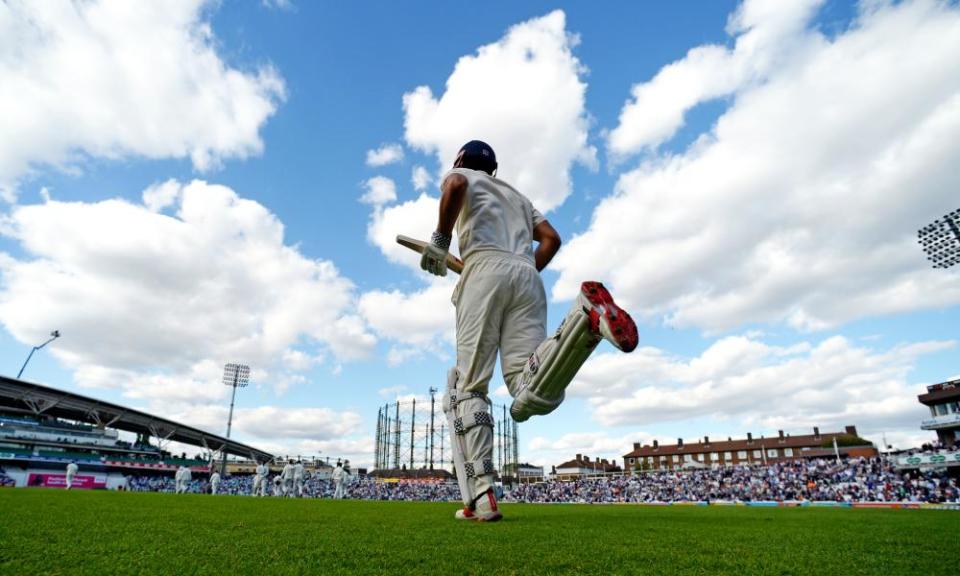Alastair Cook was a constant in cricket’s ever-changing world

When Alastair Cook made his Test debut against India, following a 10,000-mile dash from the Caribbean to Nagpur as an 11th-hour replacement for the stricken Marcus Trescothick, back home in England Leo Sayer was top of the charts with Thunder in My Heart.
This was not 1977, but 2006, and Sayer’s original single was back in vogue thanks to a remix by the house DJ known as Meck. Nevertheless, it was a different time, with cricket in the UK about to begin life behind the paywall of Sky after the heady Ashes summer the previous year, the radical new Twenty20 Cup three seasons old and the Indian Premier League still two years from changing the landscape.
That year’s Wisden, published a month after Cook announced himself with scores of 60 and 104 on debut, referred to “an expansive left-hander” in the review of Essex’s 2005 season – one that included 214 against the touring Australians – underlining how first impressions can be deceiving. This was a batsman who, for 12 perspiration and injury-free years, has been the attack-blunting rock of England’s Test team.
Because perhaps more so than Monty Panesar – who along with Ian Blackwell won his first cap on the same day as Cook – it has been the opener who has played the same Test 161 times – rather than played 161 Tests, as the old Shane Warne-ism about Monty goes – with his pared-back approach of a cut, a pull, a tuck and only the occasional cover drive anchored by that square-jawed defence throughout. His role has been to build the stage that the truly expansive players, such as Kevin Pietersen and, more recently, Ben Stokes, can perform.
If Cook has remained a constant then the sport has evolved around him, to the point where the England and Wales Cricket Board is now cooking up a new gateway drug for the gateway drug through its much-ridiculed new tournament, The Hundred. The spread of domestic Twenty20 has torn cricket from its traditional moorings through a freelance market that has given the players the power to earn huge sums outside of – or in many cases instead of – their traditional contracts.
Though Cook has always put country first, he did try to keep up in the white-ball formats. For Essex, he once smote a 57-ball Twenty20 century against Surrey in 2009 and he was even part of the national squad pushed into the ill‑fated $20m match against Allen Stanford’s Superstars in Antigua the year before (in what was hoped would keep England’s players away from the IPL). But in four T20 internationals he averaged 15 with a strike-rate of 112, never once clearing the boundary rope.
While he was handed the captaincy of England’s 50-over side in 2011 and compiled five centuries from 92 appearances, like many selections at the time it was made with a view to the Test team’s needs.
In late 2014 his own rotten form led to him being dumped on the eve of a World Cup that exposed just how badly the team management had ignored Twenty20’s impact on its older sibling. Gone were the days of accumulation before the late burst and in its place was an extended power-hitting session, something further underlined by the rise to No 1 by Eoin Morgan’s band of tattooed hellraisers.
Off the field, cricket has become intertwined with social media. The first player to fall foul of it was in 2010, when Yorkshire’s Azeem Rafiq was banned for a month and fined £500 for insulting the England Under-19s head coach, John Abrahams, on Twitter. But while nearly all players have since created their own online avatars – in many cases doing so to further their brand and sponsorship opportunities – Cook has never signed up.
Life back on the family farm, lambing between February and April and breeding turkeys for Christmas, has been his outlet away from the game.
It was in this department, however, that Cook has since admitted that he and the ECB were badly outflanked during the messy fallout from the exile of Pietersen in 2014. When he hangs up his bat this week, only Moeen Ali, who recently decided to shut down his accounts to spend less time staring into his mobile phone, will be social media-free among the current national team.
In many ways Cook’s retirement has come a year too early, for 2019, with a 50-over World Cup on home soil followed by the Ashes will be the last summer of cricket in its current form, before The Hundred crash lands into the middle of the season. An element of it will appear on terrestrial television – the BBC has rights to a handful of games – but the chances of Cook reinventing himself for this look slim.
His career – one of immense team-first obduracy, four Ashes series victories, 32 centuries, a record haul of English Test runs and yet not one of those seen live on British television outside of those subscribed to Sky Sports – is one of the driving forces behind The Hundred, after a 2016 survey showed more seven to 15-year-olds recognised the wrestler John Cena. The irony is that WWE is only available to the same audience. The next generation of players, who will now receive greater exposure than one of the country’s all-time great sportsmen, may well come to remedy this.
Cook’s own take? “Cricket is just different now. T20 has changed the game massively,” he told the BBC last week. “The pinnacle was always Test cricket and I think it still is. You don’t have to play it to become a global superstar. It’s changed but for the better. But the people in charge still have to protect Test cricket because it is very special.”

 Yahoo Sport
Yahoo Sport 





































